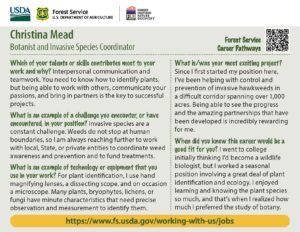Wilderness
Learn more about wilderness benefits, wilderness protection and preservation, wilderness recreation, and more with a variety of Natural Inquirer resources. Browse by topic, grade band, and resource type.
-

 CareerForests & Plants
CareerForests & PlantsUpekala Wijayratne, Ecologist

- Ph.D., Oregon State University
- USDA Forest Service
- I am a scientist working at the intersection of research and management, applying what we learn from research to land management.
- Ph.D., Oregon State University
- USDA Forest Service
- I am a scientist working at the intersection of research and management, applying what we learn from research to land management.
-

 Career
CareerJessica Dunn, Landscape Architect & Recreation Planner

- M.L.A., M.F.A., University of New Mexico
- USDA Forest Service
- A Forest Service landscape architect uses science and art to plan, design, build, and manage recreation opportunities on our national forests. They design spaces for people to connect to nature and create memories on public lands.
- M.L.A., M.F.A., University of New Mexico
- USDA Forest Service
- A Forest Service landscape architect uses science and art to plan, design, build, and manage recreation opportunities on our national forests. They design spaces for people to connect to nature and create memories on public lands.
-

 CareerForests & Plants
CareerForests & PlantsJamie Klebanski, Supervisory Natural Resource Specialist (SNRS) – Recreation

- M.S., Duquesne University
- USDA Forest Service
- An SNRS-Recreation leads a team of resource professionals who maintain and protect recreational opportunities on national forests. Some examples include trails, campgrounds, and day use areas.
- M.S., Duquesne University
- USDA Forest Service
- An SNRS-Recreation leads a team of resource professionals who maintain and protect recreational opportunities on national forests. Some examples include trails, campgrounds, and day use areas.
-

 CareerForests & Plants
CareerForests & PlantsEmily Platt, Forest Supervisor

- Ph.D., Oregon State University
- USDA Forest Service
- Forest supervisors are “line officers” responsible for everything that occurs in a national forest. I have the honor of guiding forest management on an incredible national forest landscape for a range of issues from vegetation and wildfire management to recreation and roads.
- Ph.D., Oregon State University
- USDA Forest Service
- Forest supervisors are “line officers” responsible for everything that occurs in a national forest. I have the honor of guiding forest management on an incredible national forest landscape for a range of issues from vegetation and wildfire management to recreation and roads.
-

 CareerForests & Plants
CareerForests & PlantsChristina Mead, Botanist & Invasive Species Coordinator

- B.S., Oregon State University
- USDA Forest Service
- As a botanist, I focus on the identification and management of native plants and their communities as well as management of invasive species to protect habitat.
- B.S., Oregon State University
- USDA Forest Service
- As a botanist, I focus on the identification and management of native plants and their communities as well as management of invasive species to protect habitat.
-

 CareerForests & Plants
CareerForests & PlantsAmanda Hardman, Nonvascular Botanist

- M.S., Oregon State University
- USDA Forest Service
- A nonvascular botanist focuses on the identification, biology, and ecology of bryophytes (a group of nonflowering plants that includes mosses) and lichens.
- M.S., Oregon State University
- USDA Forest Service
- A nonvascular botanist focuses on the identification, biology, and ecology of bryophytes (a group of nonflowering plants that includes mosses) and lichens.
-

 FireFire CareerForests & Plants
FireFire CareerForests & PlantsAlexa Scanlan, Prevention Technician

- B.A., MNR, University of Idaho
- USDA Forest Service
- My job in prevention is about public education and outreach, making sure that we share consumable knowledge about our forests, and how to prevent fires. I also still respond to and fight wildland fires.
- B.A., MNR, University of Idaho
- USDA Forest Service
- My job in prevention is about public education and outreach, making sure that we share consumable knowledge about our forests, and how to prevent fires. I also still respond to and fight wildland fires.
-

 FireForests & Plants
FireForests & PlantsDavid Weise, Forester

- Ph.D., University of California – Berkeley
- USDA Forest Service Scientist
- A forester studies how forests and woodlands grow, function, and are managed to provide things that people want and need from forests. Specifically, I study prescribed fire and how it can be used as a tool to manage our forests and wildlands.
- Ph.D., University of California – Berkeley
- USDA Forest Service Scientist
- A forester studies how forests and woodlands grow, function, and are managed to provide things that people want and need from forests. Specifically, I study prescribed fire and how it can be used as a tool to manage our forests and wildlands.
-

 FireForests & Plants
FireForests & PlantsLouise Loudermilk, Fire Ecologist

- Ph.D., University of Florida
- USDA Forest Service Scientist
- A fire ecologist explores the interactions between wildland fire and plant communities. I study how fires burn and how forests grow and reassemble after fire.
- Ph.D., University of Florida
- USDA Forest Service Scientist
- A fire ecologist explores the interactions between wildland fire and plant communities. I study how fires burn and how forests grow and reassemble after fire.
-

 FireForests & Plants
FireForests & PlantsW. Matt Jolly, Research Fire Ecologist

- Ph.D., University of Montana
- USDA Forest Service Scientist
- As a research fire ecologist, I study how vegetation, weather, and terrain interact to influence wildland fires.
- Ph.D., University of Montana
- USDA Forest Service Scientist
- As a research fire ecologist, I study how vegetation, weather, and terrain interact to influence wildland fires.























